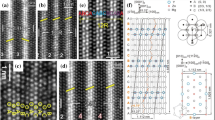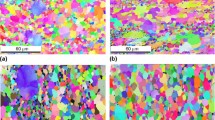Abstract
Requiring a high strength and concurrently a high ductility in materials is generally a demand for opposing properties in dislocation slip deforming materials, such as Al–Mg–Si wrought alloys. However, these are essential mechanical properties for safety parts in the mobility sector. While the strength of Al–Mg–Si wrought alloys is mainly governed by the state and density of the secondary precipitates, the deformation behavior and ductility are affected by both precipitates and crystallographic texture. The deformation during extrusion leads to the formation of characteristic textures in the bulk, which are distinct to a plane-strain deformation, and a peripheral coarse grain (PCG) layer beneath the surface. This PCG layer can have a detrimental effect on the bending ductility, which assesses the crashworthiness. However, an appropriate texture in the bulk can counteract the detrimental effect of PCG and increases the bending ductility at high strengths. Subsequently, based on EBSD investigations of bending deformed microstructures, a way to enhance bending deformation capability in Al–Mg–Si profiles is proposed.
Access this chapter
Tax calculation will be finalised at checkout
Purchases are for personal use only
Similar content being viewed by others
References
Parson N, Fourmann J, Beland J-F (2017) Aluminum Extrusions for Automotive Crash Applications. SAE Tech Pap 01–16
Ritchie RO (2011) The conflicts between strength and toughness. Nat Mater 10:817–822
Ryen Ø, Holmedal B, Marthinsen K, Furu T (2015) Precipitation, strength and work hardening of age hardened aluminium alloys. IOP Conf Ser Mater Sci Eng 89:012013
Remøe MS, Marthinsen K, Westermann I, Pedersen K, Røyset J, Marioara C (2017) The effect of alloying elements on the ductility of Al-Mg-Si alloys. Mater Sci Eng A 693:60–72
Österreicher JA, Schiffl A, Falkinger G, Bourret GR (2016) Microstructure and mechanical properties of high strength Al—Mg—Si—Cu profiles for safety parts. IOP Conf Ser Mater Sci Eng 119:012028
Lassance D, Fabregue D, Delannay F, Pardoen T (2007) Micromechanics of room and high temperature fracture in 6xxx Al alloys. Prog Mater Sci 52:62–129
Kuijpers NCW, Vermolen FJ, Vuik C, Koenis PTG, Nilsen KE, van der Zwaag S (2005) The dependence of the β-AlFeSi to α-Al(FeMn)Si transformation kinetics in Al–Mg–Si alloys on the alloying elements. Mater Sci Eng A 394:9–19
Lodgaard L, Ryum N (2000) Precipitation of dispersoids containing Mn and/or Cr in Al–Mg–Si alloys. Mater Sci Eng A 283:144–152
Sundman B, Ohnuma I, Dupin N, Kattner UR, Fries SG (2009) An assessment of the entire Al–Fe system including D03 ordering. Acta Mater 57:2896–2908
Shi C, Chen X-G (2015) Effects of Zr and V Micro-Alloying on Activation Energy during Hot Deformation of 7150 Aluminum Alloys. In: Hyland M (ed) Light Metals 2015. Springer International Publishing, Cham, pp 163–167
Hirsch J, Lücke K (1988) Overview no. 76 - I. Acta Metall 36:2863–2882
Daaland O, Nes E (1996) Origin of cube texture during hot rolling of commercial Al-Mn-Mg alloys. Acta Mater 44:1389–1411
Montheillet F, Cohen M, Jonas JJ (1984) Axial stresses and texture development during the torsion testing of Al, Cu and α-Fe. Acta Metall 32:2077–2089
Grasserbauer J, Weißensteiner I, Falkinger G, Mitsche S, Uggowitzer PJ, Pogatscher S (2020) Evolution of Microstructure and Texture in Laboratory- and Industrial-Scaled Production of Automotive Al-Sheets. Materials 13:469
Molodov DA, Shvindlerman LS, Gottstein G (2003) Impact of grain boundary character on grain boundary kinetics. Int J Mater Res 94:1117–1126
Frodal BH, Morin D, Børvik T, Hopperstad OS (2020) On the effect of plastic anisotropy, strength and work hardening on the tensile ductility of aluminium alloys. Int J Solids Struct 188–189:118–132
Henn P, Liewald M, Sindel M (2018) Investigation on crashworthiness characterisation of 6xxx-series aluminium sheet alloys based on local ductility criteria and edge compression tests. IOP Conf Ser Mater Sci Eng 418:012125
VDA 238–100 (2020) Plate bending test for metallic materials
De Graef M (2020) A dictionary indexing approach for EBSD. IOP Conf Ser Mater Sci Eng 891:012009
Bachmann F, Hielscher R, Schaeben H (2010) Texture Analysis with MTEX – Free and Open Source Software Toolbox. Solid State Phenom 160:63–68
Jin SB, Zhang K, Bjørge R, Tao NR, Marthinsen K, Lu K, Li YJ (2015) Formation of incoherent deformation twin boundaries in a coarse-grained Al-7Mg alloy. Appl Phys Lett 107:091901
Li BQ, Sui ML, Li B, Ma E, Mao SX (2009) Reversible Twinning in Pure Aluminum. Phys Rev Lett 102:205504
Hai S, Tadmor EB (2003) Deformation twinning at aluminum crack tips. Acta Mater 51:117–131
Author information
Authors and Affiliations
Corresponding author
Editor information
Editors and Affiliations
Rights and permissions
Copyright information
© 2023 The Minerals, Metals & Materials Society
About this paper
Cite this paper
Goik, P., Schiffl, A., Höppel, H.W., Göken, M. (2023). The Role of Through-Thickness Variation of Texture and Grain Size on Bending Ductility of Al–Mg–Si Profiles. In: Broek, S. (eds) Light Metals 2023. TMS 2023. The Minerals, Metals & Materials Series. Springer, Cham. https://doi.org/10.1007/978-3-031-22532-1_77
Download citation
DOI: https://doi.org/10.1007/978-3-031-22532-1_77
Published:
Publisher Name: Springer, Cham
Print ISBN: 978-3-031-22531-4
Online ISBN: 978-3-031-22532-1
eBook Packages: Chemistry and Materials ScienceChemistry and Material Science (R0)




